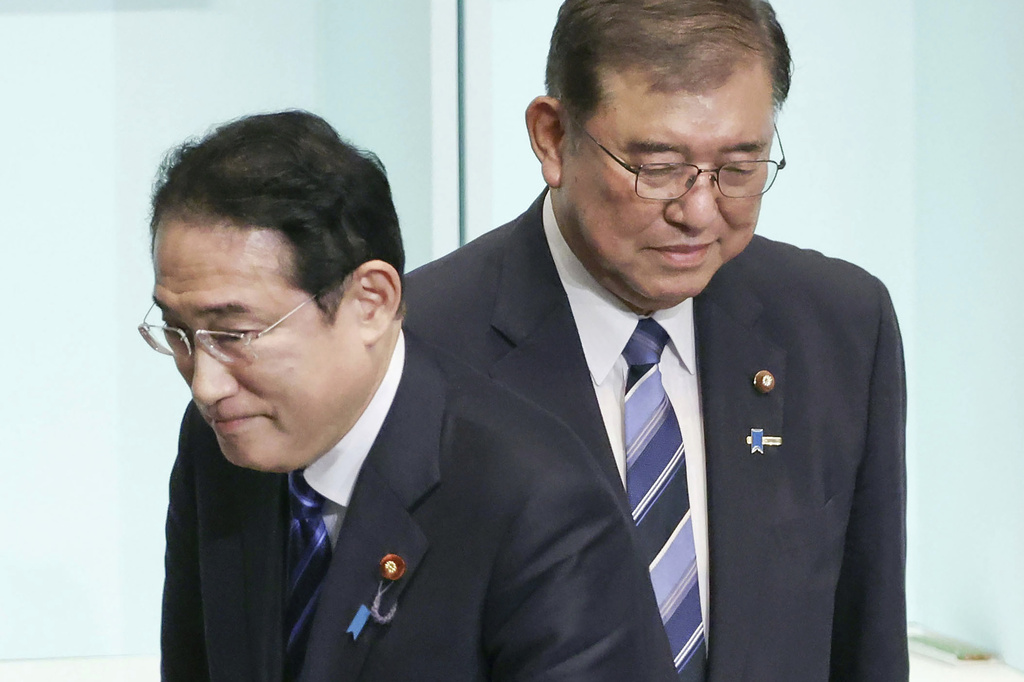Japan’s New Leader Shigeru Ishiba Succeeds Fumio Kishida \ Newslooks \ Washington DC \ Mary Sidiqi \ Evening Edition \ Fumio Kishida resigned as Japan’s Prime Minister, allowing Shigeru Ishiba to step in as his successor. Ishiba, recently chosen as the Liberal Democratic Party leader, is expected to be formally elected by Japan’s parliament. His policies focus on enhancing Japan’s defense and forming an Asian NATO-like alliance.
Ishiba’s Succession Quick Looks:
- Kishida Resigns After Three-Year Term: Prime Minister Fumio Kishida stepped down with his Cabinet, opening the way for new leadership.
- Ishiba Set to Take Over Leadership: Shigeru Ishiba was chosen as the Liberal Democratic Party’s leader, poised to take over as Prime Minister.
- Parliamentary Election Expected: Ishiba announced his intention to call for a parliamentary election on October 27.
- Key Leadership Announcements: Shinjiro Koizumi will head the election task force, and appointments for foreign and defense ministers have been previewed.
- Defense Policy Goals: Ishiba proposed an Asian version of NATO, regional collaboration for security, and joint management of U.S. military bases in Japan.
Deep Look:
Japan’s political landscape is witnessing a significant shift, as Prime Minister Fumio Kishida officially resigned along with his Cabinet on Tuesday, marking the end of his three-year tenure. Chief Cabinet Secretary Yoshimasa Hayashi confirmed Kishida’s resignation, announcing it during a Cabinet meeting. This development sets the stage for Shigeru Ishiba, a well-known figure in the governing Liberal Democratic Party (LDP), to step into the top leadership role. Kishida’s resignation, although anticipated, comes amidst a backdrop of political scandals and declining public support, as he aims to make way for a fresh face to lead the party and the nation.
Shigeru Ishiba, who was selected as the LDP leader last Friday, is now set to become Japan’s new Prime Minister. With the LDP holding a commanding majority in Japan’s parliament, Ishiba’s election to the role later in the day is virtually assured. This transition symbolizes a strategic shift within the LDP, which has remained the dominant political force in Japan since the end of World War II, with only a few interruptions in its rule. Kishida, who took office in 2021, found his popularity waning as his administration faced multiple scandals and criticism, prompting the LDP to seek a change in leadership to restore its credibility and regain voter support.
Following his expected confirmation by parliament, Ishiba is anticipated to announce his new Cabinet later today. In an early move that sets the tone for his leadership, Ishiba has already begun filling key party roles. He appointed former Environment Minister Shinjiro Koizumi—who also participated in the recent LDP leadership race, finishing third—as the head of the party’s election task force. This strategic appointment signals an attempt to create unity within the party and leverage Koizumi’s popularity among the younger population.
On Monday, Ishiba also announced his intention to call for a parliamentary election, tentatively scheduled for October 27. By moving quickly to secure a public mandate, Ishiba aims to reinforce his position and ensure the stability of his administration. “I believe it is important for the new administration to gain the public’s judgment as soon as possible,” Ishiba stated, indicating his focus on securing legitimacy and popular support from Japan’s citizens. Early elections would also offer the LDP a chance to refresh its image and distance itself from the controversies surrounding Kishida’s administration.
Ishiba has signaled a robust defense and security agenda that could redefine Japan’s role in the regional geopolitical landscape. Central to his security vision is the creation of an Asian version of NATO, emphasizing the necessity for a collective defense framework in Asia, where countries are increasingly concerned about China’s expanding influence and military capabilities, as well as North Korea’s nuclear ambitions. In a recent article for the Hudson Institute, Ishiba argued that Asia’s lack of a collective defense system, like NATO in Europe, leaves the region vulnerable to conflicts without a shared obligation for mutual defense. He highlighted the importance of creating alliances that could deter aggression, specifically pointing to the rising threats posed by China, Russia, and North Korea.
Moreover, Ishiba has proposed strengthening existing security partnerships by integrating initiatives such as the Quad—a security dialogue between the United States, Japan, Australia, and India—with other bilateral and multilateral frameworks involving South Korea, New Zealand, and the Philippines. His proposals also include a controversial idea of sharing control over U.S. nuclear weapons stationed in the region, intended as a deterrent against adversaries. This bold stance reflects his commitment to bolstering Japan’s defense posture in an increasingly uncertain and competitive security environment.
In addition to broader defense plans, Ishiba is expected to appoint individuals with a strong defense background to key ministerial positions. Takeshi Iwaya, a veteran in foreign affairs, is expected to become the new Foreign Minister, while Gen Nakatani, who has significant expertise in defense, is likely to be named the Defense Minister. These appointments align with Ishiba’s focus on ensuring that Japan’s leadership is prepared to handle complex security challenges. Notably, Ishiba has also emphasized Japan’s need to work toward a more balanced partnership with the United States, calling for a more equal Japan-U.S. security alliance, which would include the joint management of U.S. military bases in Japan and exploring the possibility of establishing Japanese Self Defense Force bases on U.S. soil.
On Friday, Ishiba highlighted recent incursions by Chinese and Russian military aircraft into Japanese airspace and the frequent missile launches by North Korea as clear indicators of the need for a reinforced defense strategy. He views these incidents as part of a broader pattern of aggression that necessitates a proactive approach to safeguard Japan’s national security. Ishiba’s vision for an Asian NATO also aims to create stronger partnerships among regional powers to counterbalance the influence of China and Russia, creating a network of allied countries capable of responding collectively to threats.
Domestically, Ishiba’s leadership also promises continuity in economic and social policies. He has pledged to continue with Kishida’s economic agenda, aimed at pulling Japan out of its long-standing struggle with deflation and boosting real wage growth. Addressing Japan’s pressing demographic issues, such as its aging population and declining birthrate, will also be high on his agenda. These challenges are critical as they have significant implications for the country’s labor market, economic productivity, and social welfare systems. Ishiba aims to implement policies that will not only spur economic growth but also make Japan more resilient to natural disasters, an issue that has consistently affected the country due to its geographic vulnerabilities.
The Liberal Democratic Party, which has governed Japan for most of the post-war era, appears to have recognized the need for a new leader with centrist views to bridge the gap between the public and a government whose reputation has been tainted by corruption scandals. Ishiba’s extensive experience, including past roles as Defense Minister, Agriculture Minister, and LDP Secretary General under former Prime Minister Shinzo Abe, positions him as a capable and seasoned leader. He is seen as someone who can strike a balance between maintaining Japan’s traditional alliances while also responding to emerging regional challenges.
Ishiba’s vision also includes addressing public concerns about governance and corruption. The LDP has faced considerable criticism over scandals that damaged Kishida’s popularity, and Ishiba’s leadership is viewed as a fresh start that may restore trust in the party. His moderate, centrist views may appeal to a broader spectrum of voters, helping the LDP push back against liberal-leaning opposition parties and strengthen its hold on power.
Shigeru Ishiba’s rise to Japan’s premiership marks the beginning of a new chapter, with a leadership that is focused on rejuvenating Japan both domestically and on the global stage. As the new Prime Minister, his policies on defense, security, and economic reform will play a significant role in shaping Japan’s future at a time of increasing global uncertainties and domestic challenges. His leadership could be pivotal in determining how Japan navigates its role as a regional power while maintaining its long-standing alliances and adapting to shifting dynamics in Asia and beyond.







